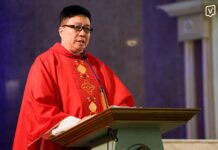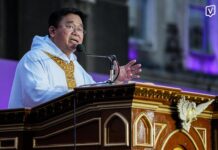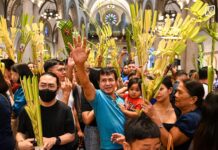(Remarks delivered by Fr. Rolando V. de la Rosa, O.P., former rector of the University of Santo Tomas, during the 2020 homecoming of the UST Alumni Priests’ Association.)
We often hear students declare proudly: “I am a Thomasian. I am proud of my Thomasian identity” One wonders if they understand what that means.
For me, when I say “I am a Thomasian,” I refer to my “place identity,” whereby a place becomes incorporated into my notion of who I am. When I first entered the portals of the university, I did not just arrive in a place, I enter into a whole web or relationships, histories, and personal narratives by which the place is partly constituted.
And by being part of such a web, I become embedded in the university and the university becomes internalized into my own self-understanding. I develop a sense of belonging and this deeply influences my sense of identity, meaning, value, and purpose.
I acquire this Thomasian identity in three ways: by selective assimilation, by which significant elements in the place are absorbed into my identity structure; by accommodation, by which my identity adjusts to incorporate those elements in the place or environment that I find initially strange or destabilizing; and by critical rearrangement, whereby the elements in the place are ordered according to my developing hierarchy of values.
Through my years of formation in the university, I absorb, as though by osmosis, Thomasian values like commitment, competence, and compassion. I am given opportunities to live as a person with a mind enlightened by faith, a heart attuned to truth and virtues, and a passion for what is right and true. I may not fully succeed in this endeavor, but somehow, through honest striving and God’s grace I may get there.
This is why I call UST my alma mater, a “soul mother” to which I am spiritually connected, not only through the education I received from it, the relationship I developed with the students and teachers, but also through my close familiarity with the school itself as a place teeming with significant landmarks that kindle my Thomasian spirit and identity.
For instance, every time I behold the majestic main building, I feel an overwhelming pride that I am a Thomasian. The main building has become the face of UST, and I admire the foresight of its builder, the eminent Dominican Fr. Roque Ruaño, OP, who learned everything he knew about building construction and design from this university itself. He designed it to withstand earthquakes, floods, typhoons, and other calamities. The main building has become a sort of a sacrament – it makes present what it signifies: the classic character of education that I received from the university. Classic, in the sense of timeless and forever timely.
The façade of the building prominently displays proofs of its Catholic character: the cross, the clock, and the three statues that dominate it. The cross is the symbol of our redemption, and together with the clock, we are reminded of salvation history. The three statues are collectively known in Latin as tria haec (“these three”) a phrase derived from ICorinthians 13:13 where St. Paul declares: “These three things last forever: faith, hope, and love. But the greatest of these is love.” The tria haec tells us that the history of UST is a history that is impelled by faith, propelled by hope, and compelled by love. What other university can claim such a sublime past?
I also take pride in being a Thomasian whenever I pass through the Arch of the Centuries, I feel like shouting to the whole world that I belong to a university that had survived several centuries of colonial battles for supremacy, two World Wars, countless disasters, as well as economic and political upheavals in the country.
The Arch of the Centuries is not just the “ruins” of the door of the original main building of UST in Intramuros. It reminds us of the stubborn will of UST to survive, to be relevant, to impress its mark on every student that enters its portal. Thomasians everywhere who have the Arch of the Centuries in their heart will never lose hope even in their darkest hours. Why should they? They possess a symbol of God’s unending grace.
I feel proud of saying I am a Thomasian because while all of Sampaloc area is cramped by houses, shanties, high rise buildings, condos, and commercial establishments, and strangled by narrow streets teeming with cars and jeepneys, UST campus is an expansive oasis where one can walk, run, or simply stand and allow oneself to savor peace amidst the swirling, throbbing, never-ending motion around him.
Within the campus are the magnificent Benavides garden, the Plaza Mayor, the Quadricentennial Square, and the parade grounds that have become the venue for many extraordinary events like our being awarded the Guinness Book of Records for having created the World’s biggest human Cross.
It was in this parade grounds that we witnessed the visit of three Popes. It was here that several years ago, one former President of the Philippines, in a speech delivered during the re-enactment of the liberation of UST from the Japanese forces, declared that the University of Santo Tomas could serve as a model for the country’s quest for peace and progress. With the vast army of excellent Thomasians everywhere, excelling in their various professions, and doing great things for our country, he said that the acronym U-S-T signifies what is needed to pole vault to a progressive future. For him, U-S-T means UNITY, SOLIDARITY, TEAMWORK.
My thirst for spiritual food is enkindled by the beautiful Santisimo Rosario Chapel, the Rosarium where students have a place where they can pray and meditate on the Rosary, and a Carillon where each bell depicts a Thomasian martyr, who died while preaching the faith in other countries. When the bells ring every 12 noon and 6 pm everyone pauses to pray the angelus. Students, teachers, and cars are at a standstill in the campus during the angelus. Clearly if UST had withstood so many trials and difficulties, it must be because it is not only a teaching institution but a praying community.
When I pass by the walkways and see the bulletin boards and the LED monitors showing the names of outstanding Thomasians: Board topnotchers, UAAP champions, winners in national and international competitions, eminent public servants, professionals, and civic leaders, I vicariously share their triumphs and bask in their glory. My heart rejoices at belonging to such a splendid group of human beings.
One former Chief Justice of the Supreme Court who is an alumnus of the university once said: “There is something that makes our UST education uniquely beyond the realm of the ordinary. I refer to UST’s remarkable preservation of our rich Christian heritage, so intimately and inextricably woven into our Filipino heart and soul. In a very real sense, the University of Santo Tomas is not only the alma mater of us, its graduates, but also the alma mater of the Philippines as a Filipino nation.” Coming from the Chief Justice himself, those words sounded like a Supreme Court decision: definitive, legally binding, and uttered with finality.
His declaration that the University of Santo Tomas is the alma mater, or spiritual mother of the Filipino nation has a historical basis. For indeed, practically all those who gave birth to the Philippines as a nation were once upon a time, students in UST. Most of the pioneers of various professions in the country were alumni of UST. Most of the priests and bishops who worked to build an indigenous Filipino Church were alumni of the university and the UST Central Seminary. And all those who helped build the Filipino family through Catholic values and doctrines were graduates of UST. The University has produced, not only excellent leaders, entrepreneurs, academicians, and pioneering professionals, but also saints, heroes, and martyrs. Which university in the country has alumni who can boast of such an exalted pedigree?
The presence of the UST Campus Ministry and the UST SIMBAHAYAN (Tomasino para sa Simbahan, Bayan, at Tahanan), the centerpiece project of our Quadricentennial Celebration in 2011, also boosts my Thomasian pride and identity. The Campus Ministry together with the Dominican Regents, religion and theology teachers, takes care of the religious and moral formation of students, not only in the classroom, but in periodic retreats and recollections. Meanwhile, the UST SIMBAHAYAN, the university’s unified outreach program, encapsulizes what UST has been doing for the past 400 years: building the nation, building the church, and building the family through our alumni.
I still remember when UST adopted an Aeta village formerly displaced by the Pinatubo eruption and is now a self-sustaining community. In one faculty convocation, the leader of this Aeta village spoke a very inspiring message: “Noong wala pa ang UST sa aming mga lugar, kaming mga katutubo ay madalas maging biktima ng mga manloloko at mga politiko. Darating sila at papakitaan kami ng mga papel na hindi naman naming alam basahin. Ang sabi nila, nabili na daw nila ang aming mga lupain. Sa tulong ng pamantasan ng Santo Tomas, kami’y natutong magbasa at sumulat. Nabigyan din kami ng kabuhayan at mga bahay. Ngayon, buong pagmamalaki naming sasabihin, kami’y mga Aetang Pilipino. Aetang Tomasino.”
Sometimes though, as a proud Thomasian I feel hurt whenever I hear people hurling unfair criticisms against the university. Yes, the university is not perfect but no family or institution is. How does an institution die? It dies by being neglected or abandoned by those who are supposed to nurture and protect it.
I admire those proud alumni who express their Thomasian identity and spirit not only by lip service, but by effective action. They work to foster its good name and promote its advancement. These are the alumni who, when they attend a homecoming, ask: How can I give back? How can I help my alma mater achieve its mission and vision?
So today I invite you to declare with conviction, that your identity is indelibly marked with the name “Thomasian.” It is your alma mater, your spiritual home. Home is a place that you can never really leave behind. You bring it wherever you go because it has become a part of the fabric of your life.
With God’s grace and your continuing support and love, I am certain that the University of Santo Tomas will live on to another one hundred years and beyond.
***
Fr. Rolando V. de la Rosa, O.P. was Rector of the University from 1990 to 1998 and 2008 to 2012, and chairman of the Commission on Higher Education from 2004 to 2005. He is also a former Witness (religion section) editor of the Varsitarian.














